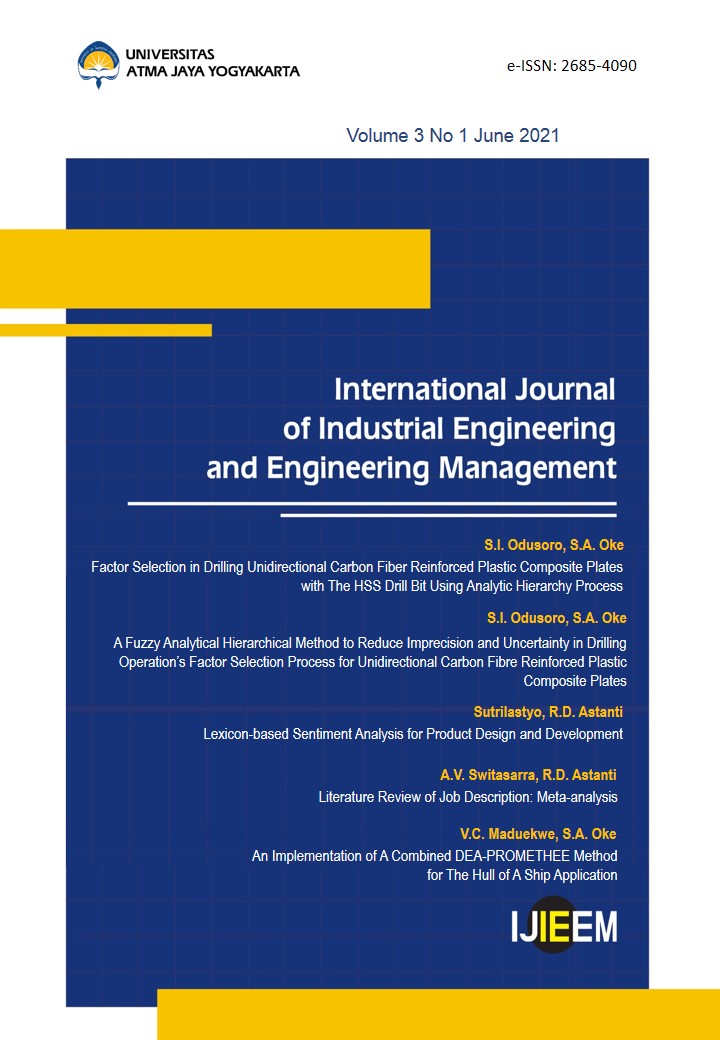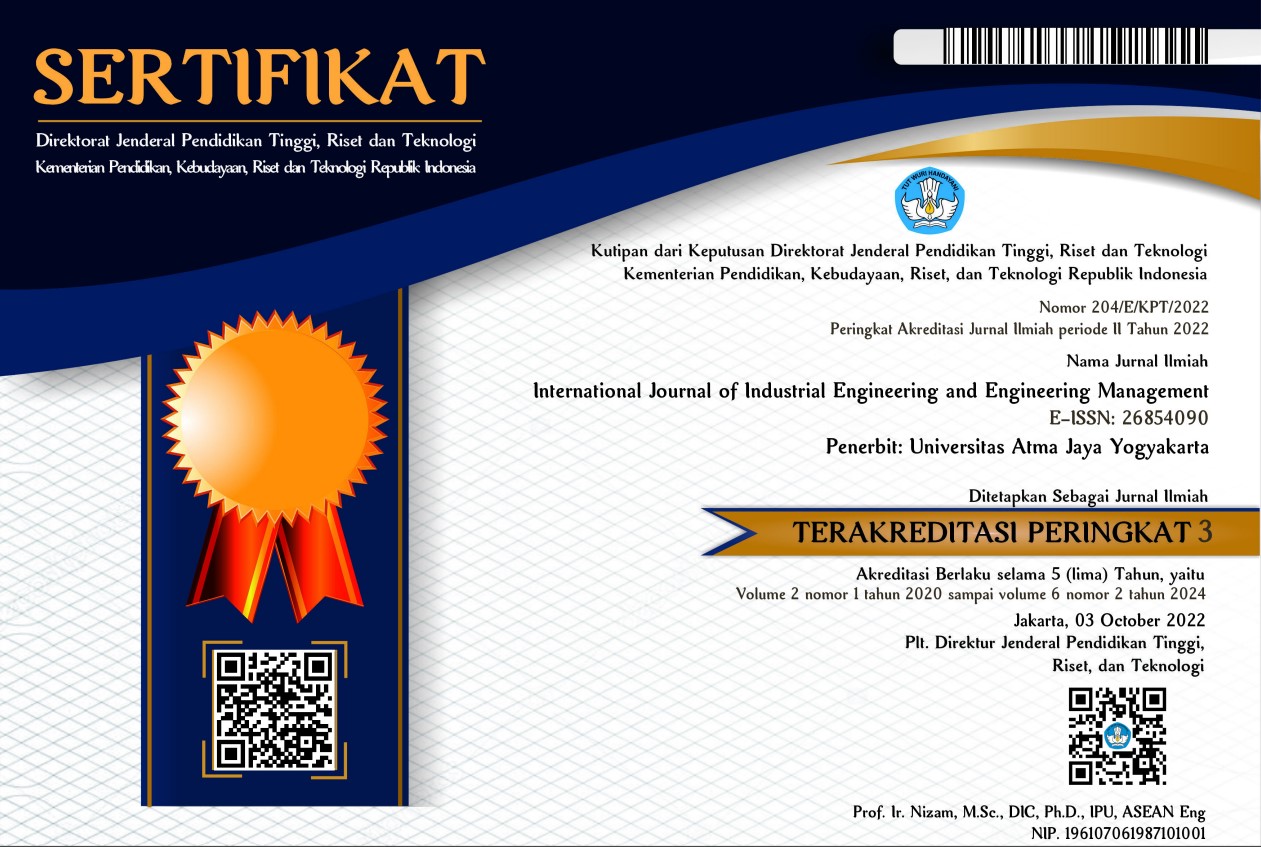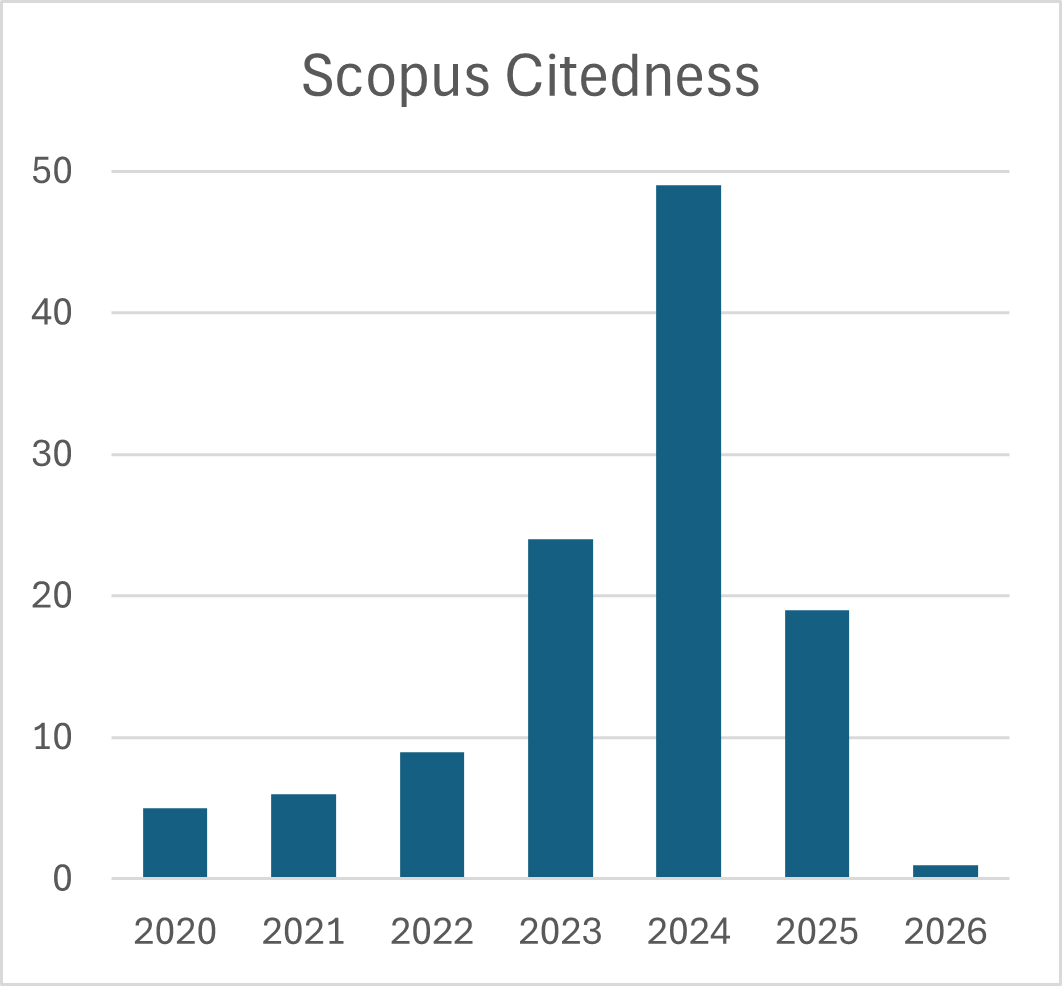Lexicon-based Sentiment Analysis for Product Design and Development
DOI:
https://doi.org/10.24002/ijieem.v3i1.4351Keywords:
sentiment analysis, product design, product development, voice of customerAbstract
This paper discusses the role of text mining and sentiment analysis in collecting and analyzing customers’ verbatim/voice of the customer for product design and development. In the illustration case of designing car underbody, the data were collected from a car online forum discussion website and processed using text mining techniques with “underbody” as a keyword. The result of the analysis finds there are worries regarding underbody durability against rust and damages. This finding is used as a reference point for the car underbody design process.
References
Abdulla, N. A., Ahmed, N. A., Shehab, M. A., & Al-Ayyoub, M. (2013). Arabic sentiment analysis: Lexicon-based and corpus-based. 2013 IEEE Jordan Conference on Applied Electrical Engineering and Computing Technologies, AEECT 2013.
Aguwa, C., Olya, M. H., & Monplaisir, L. (2017). Modeling of fuzzy-based voice of customer for business decision analytics. Knowledge-Based Systems, 125(November), 136–145.
Alsaeedi, A., & Khan, M. Z. (2019). A study on sentiment analysis techniques of Twitter data. International Journal of Advanced Computer Science and Applications, 10(2), 361–374.
Buljac, A., Kozmar, H., & Džijan, I. (2016). Aerodynamic performance of the underbody and wings of an open-wheel race car. Transactions of Famena, 40(2), 19–34.
Cen, P. (2020). Predicting Consumers ’ Brand Sentiment Using Text Analysis on Reddit [Joseph Wharton Scholars]. https://repository.upenn.edu/joseph_wharton_scholars/95.
Cho, J., Kim, T.-K., Kim, K.-H., & Yee, K. (2017). Comparative Investigation On The Aerodynamic Effects Of Combined Use of Underbody Drag Reduction Devices Applied to Real Sedan. International Journal of Automotive Technology, 18, 293–300.
Desai, S., Leylek, E., Lo, C. M. B., Doddegowda, P., Bychkovsky, A., & George, A. R. (2008). Experimental and CFD comparative case studies of aerodynamics of race car wings, underbodies with wheels, and motorcycle flows. SAE Technical Papers, February 2018.
Dey, A., Jenamani, M., & Thakkar, J. J. (2018). Senti-N-Gram: An n-gram lexicon for sentiment analysis. Expert Systems with Applications, 103, 92–105.
Dittmar, H., & Plaggenborg, H. (2019). Lightweight vehicle underbody design. Reinforced Plastics, 63(1), 29–32.
Folkestad, J. E., & Johnson, R. L. (2001). Resolving the conflict between design and manufacturing: Integrated Rapid Prototyping and Rapid Tooling (IRPRT). Journal of Industrial Technology, 17(4), 1–7.
Gurusami, S. A. (1999). Decision analysis in product development - A case study. SAE Technical Papers, 724.
Heidemann, R., Rodrigues, A. F. A., Bohrer, A., Gertz, C. L., & Cervieri, A. (2018). Underbody aerodynamics: Drag coefficient reduction in road vehicles. SAE Technical Papers, September.
Hu, M., & Liu, B. (2004). Mining and Summarizing Customer Reviews. Proceeding of the ACM SIGKDD International Conference on Knowledge Discovery and Data Mining (KDD-2004). http://www.cs.uic.edu/~liub/FBS/sentiment-analysis.html.
Huminic, A., & Huminic, G. (2020). Aerodynamics of curved underbody diffusers using CFD. Journal of Wind Engineering and Industrial Aerodynamics, 205(July), 104300.
Jeong, B., & Yoon, J. (2016). Identifying product opportunities using topic modeling and sentiment analysis of social media data. http://apiems2016.conf.tw/site/userdata/1087/papers/0208.pdf.
Ikiz, A. K., & Özdağoğlu, G. (2015). Text Mining as a Supporting Process for VoC Clarification. Alphanumeric Journal, 3(1), 25–40 .
Khedr, A. E., Salama, S. E., & Yaseen, N. (2017). Predicting stock market behavior using data mining technique and news sentiment analysis. International Journal of Intelligent Systems and Applications, 9(7), 22–30.
Kotler, P., & Keller, K. L. (2006). Marketing Management (12 Edition). Prentice-Hall.
Kreuzbauer, R., & Malter, A. J. (2005). Embodied cognition and new product design: Changing product form to influence brand categorization. Journal of Product Innovation Management, 22(2), 165–176.
Moos, E. (2014, April 1). Light Weight Materials for Aerodynamic, Acoustic and Thermal Management Improvements in Underbody Applications.
Mulay, R., & Khanna, V. T. (2017). A Study on the Relationship between the Voice of Customer with the Cost of Quality in Processes of Professional Higher Education Institutions. South Asian Journal of Management, 24(4), 55–72.
Muyl, F., Dumas, L., & Herbert, V. (2004). Hybrid method for aerodynamic shape optimization in automotive industry. Computers and Fluids, 33(5–6), 849–858.
Ortega, J. M., & Salari, K. (2004). An experimental study of drag reduction devices for a trailer underbody and base. 34th AIAA Fluid Dynamics Conference and Exhibit.
Park, H. (2019). Development of a Test System to Measure Squeak Propensity of Vehicle Underbody Components. University of Cincinnati.
Park, J., Lee, H., Lee, J. H., & Suh, H. (2018). Feature-based sentiment word selection and rating for system design. Journal of Industrial Electronics Technology and Application, 1(4), 54–57.
Rana, V. S., Gosai, D. C., & Joshi, D. S. (2018). Enhancement of Car Life, Engine Performance, and Emission Test by Using Coatings. International Journal of Modern Trends in Engineering and Science, 05(2017), 44–49.
Shah, F. P., & Patel, V. (2016). A review on feature selection and feature extraction for text classification. Proceedings of the 2016 IEEE International Conference on Wireless Communications, Signal Processing and Networking, WiSPNET 2016, 2264–2268.
Shukri, S. E., Yaghi, R. I., Aljarah, I., & Alsawalqah, H. (2015). Twitter sentiment analysis: A case study in the automotive industry. 2015 IEEE Jordan Conference on Applied Electrical Engineering and Computing Technologies, AEECT 2015.
Singh, S. R., & Sharma, S. (2013). A global optimizing policy for decaying items with ramp-type demand rate under two-level trade credit financing taking account of preservation technology. Advances in Decision Sciences, 2013, 1–16.
Yuan, Z., & Wang, Y. (2017). Effect of underbody structure on aerodynamic drag and optimization. Journal of Measurements in Engineering, 5(3), 194–204.
Downloads
Published
How to Cite
Issue
Section
License
Copyright (c) 2021 International Journal of Industrial Engineering and Engineering Management

This work is licensed under a Creative Commons Attribution 4.0 International License.








